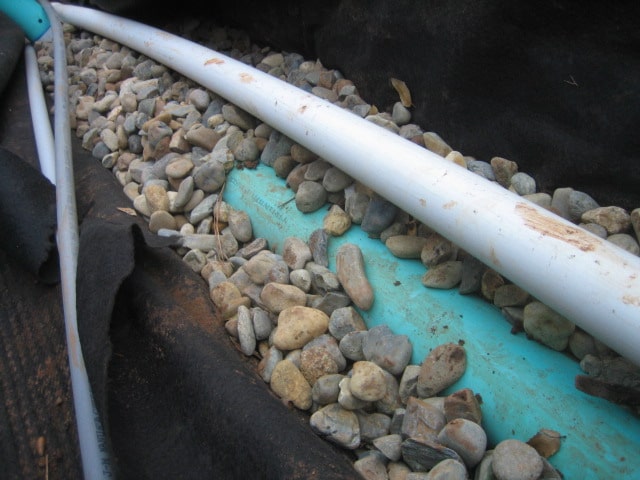
What Is a French Drain?
Drainage issues around your home can damage your landscaping, decrease the comfort of your backyard, and, most importantly, cause significant problems in the foundation. Fortunately, French drains offer an easy and effective solution. In addition to expertly installing these systems, our team at Align Foundation Repair can explain how they work and why they’re so beneficial to homeowners.
A French drain uses a buried pipe to collect water and divert it to a place where it can be better absorbed into the ground. It is a specific style of yard drain that allows for broad collection of water. Relying on nothing but smart design and gravity, these drains feature a pipe with holes facing upwards. As the ground becomes saturated, water seeps in through the holes and collects in the pipe. At this point it can flow freely to lower ground. Align uses only PVC pipes for French drains, since they provide the best in both performance and durability. A smart, simple, and highly functional design that’s been in use for centuries all around the globe, it’s no wonder French drains are a popular water management solution throughout the American South.
Origins of French Drains
French drains get their name from Henry Flagg French, an American inventor and lawyer. In 1859, French published a book discussing different drainage systems, including the one associated with his name.
French sought effective methods to alleviate water accumulation on farms, notorious for ruining crops and decreasing yields. His invention was initially called a cellar drain, which harkens back to his belief that flooded basements were a key factor in ill health.
The Basics of French Drains
A French drain consists of four basic components to facilitate the efficient removal of water from around a home’s foundation and include the following:
- Trench – Installers will excavate a trench on your property for the essential components. Trench depth varies but typically measures from one to two feet.
- Perforated Piping – Unlike standard pipes, perforated piping contains numerous small holes. These holes allow water to flow into the pipe, which transfers it to another location.
- Landscaping Fabric – Landscaping fabric is made from water-permeable plastic, creating a barrier between the perforated pipe and weeds, dirt, and other debris. Without it, the underground pipe would likely become clogged.
- Gravel – Trenches are filled with gravel to control water flow into the pipe. Gravel is positioned at the bottom of the trench, while sand is deposited on the top.
Choosing the correct type of gravel is integral to a well-functioning French drain. In terms of size, bigger is better, as larger gravel is more effective at avoiding clogs, e.g., ½ inch or 1 inch wide. Limestone & river rock are good choices, as it’s more robust and less likely to wear down after extended water exposure. It should also be washed, eliminating debris that could cause clogs.
How Does a French Drain Work?
When property lacks hills and slopes, water is more likely to remain stagnant. Wet, dense soil will push against the concrete of the foundation, which can cause cracks to form. Over time, these cracks will grow larger, allowing moisture to seep into the home, typically within the basement.
French drains allow for more effective drainage thanks to their design. Pooling water in a backyard will seep through the gravel layer to the perforated piping below. It will direct water from the property to another area where it can sufficiently drain. Sometimes, it can be routed to a rain barrel or a municipal system, such as a storm drain.
How are French Drains Installed?
Installing a French drain is a fairly straightforward procedure. First a trench is dug from where unwanted water collects to where the property owner wants it diverted. This usually means digging a small trench from around foundation, driveway or lawn, to lower ground. Then a drainage pipe with openings cut along the top is installed. This pipe is often wrapped in a fiber cloth to prevent small debris from clogging the holes. Then the trench is lined with a combination of filler fabric and heavy mill plastic, and back-filled with gravel. In most cases, the gravel remains exposed to allow for both subterranean and surface collection.
Benefits of a French Drain
For all their simplicity, French drains offer many great benefits:
- Easy installation means that drainage issues on your property can be solved efficiently and cost-effectively.
- These systems save money on expensive repairs, including foundation and water remediation.
- Proper drainage helps maintain your home’s curb appeal, as water accumulation won’t affect plants, flowers, and grass.
- Pooling water in your backyard can attract pests, so water elimination ensures a healthier environment.
- Finally, you’ll get more enjoyment out of your property when you have a clean, dry backyard.
Contact Align Foundation for a Free Estimate
Poor drainage on your property can cause numerous issues, both inside and outside of your home. French drains are a popular solution because they can effectively move water away from your home’s foundation and require very little upkeep.
Contact Align Foundation Repair to discuss French drain installation or determine whether your existing system needs assistance. We offer extensive drainage services in DFW.

